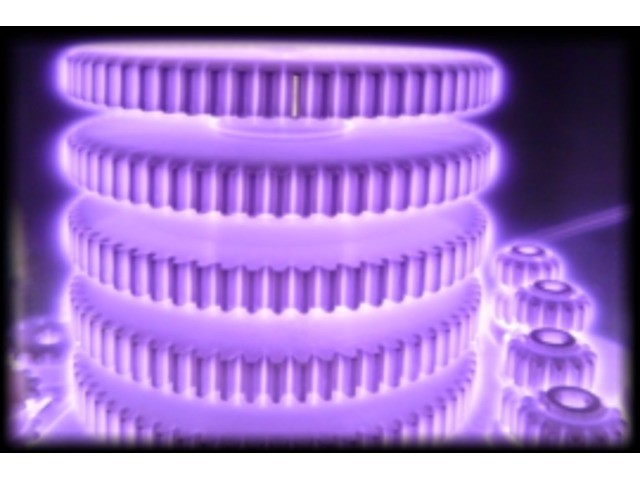A review of the Pulsed Plasma Ion Nitriding of Aluminum Extrusion Dies Presented by, David Pye
“The process of pulsed plasma ion nitriding can now be seriously considered to be a mature and accepted procedure for the surface treatment process of pulsed plasma ion nitriding.
The method of plasma ion nitriding was initially developed by Dr’s Berghaus and Wenheldt during the mid-1920’s up to the early 1930’s. The process was based on the use of partial pressure vessel which was back filled, with nitrogen and hydrogen at a partial pressure within the process vessel and an electrical charge was introduced to create the plasma glow.
Although this was seen as a unique procedure, it was not fully controllable simply because it relied upon a constant electrical (cathode anode system) voltage.
During the early to mid-1970s/1980’s considerable research work was conducted at the University of Aachen in Germany by Dr’s Stramke, Gruen and Stein . Their work examined the ability to utilize a variable voltage system and also to incorporate the ability to vary the process cycle time (voltage on and off).
It was with this technology that the process control rapidly changed from a difficult process control ability, to an ability that was now bringing an almost perfect controllable process system.
The process now can act in a similar manner as in electroplating system operates with the anodic and cathodic principles. The furnace hearth plate is now
connected as the cathode and the furnace vessel wall is connected as the anode. When the process chamber is filled with the appropriate process gases, the process gases act in exactly the same manner as a liquid electro plating system would operate.
What advantages does pulsed plasma ion nitriding technology present to the aluminum extrusion company and in particular to the die maker whose responsibility it is to both manufacture and maintain the particular extrusion die.
1.0). The process temperature can be reduced to accommodate both temperature sensitive steels as well as geometrically sensitive tool designs.
2.0) The process temperature ramp up to the operational temperature can be preprogrammed without unnecessary gas consumption. This is simply because the whole system is at a negative pressure condition within the process vessel
3.0) Low energy consumption in both process gas and plasm energy.
4.0). Pre-cleaning of the die is accomplished by what is known as sputter cleaning, which can be likened to that of atomic shot blasting.
5.0). The process uses only environmentally friendly, and nonpolluting gases.
6,0). Lower operating costs in spite of a higher capital investment as opposed to gas nitriding or salt bath nitriding.
7.0). No effluent.
8.0). Minimal maintenance procedures necessary.
9.0). Lower operator costs because the process is controlled by PC PLC systems. However, there is still the operator costs for loading and unloading the process chamber.
10.0). The system can be successfully integrated into a production line without any offensive smells which can arise from ammonia gas nitriding.
11.0). Better metallurgical control and a better case formation and case uniformity.
12.0) Process temperature control records the component part temperature rather than the vessel temperature necessary in the process of gas nitriding.
13.0. Overheating which was previously a problem on plasma nitriding before the use of pulsed technology can now be eliminated, simply because of the voltage control, Pulse duration, and Pulse repetition.
14.0). By the introduction of a very small amount of methane to encourage the formation of an epsilon nitride compound layer, the die life can be extended dramatically than with conventional methods of nitriding.
The aluminum industry is striving for excellence with economical advantages. Throughout the industry, extrusion techniques are continually being updated two more efficient methods of manufacture, improved methods of presenting the billet to the die, improved RAM designs have also taken place and been integrated to, improved methods of die making have also taken place with the advent of the EDM method of die making. All these are designed to improve the efficiency of the extrusion process.
But only a very limited amount of investigative work has been carried out on the heat treatment of the die itself. This is the point of the whole process that can either make or break the die (literally) the production throughput, and the efficiency of the press.
Ion nitriding using the pulsed Plasma technique is a process which offers the aluminum industry the option of controlling the diffused die case formation to create the optimum metallurgy suitable for both die and press.
It is now becoming a process which has gained wide acceptance in Europe, Eastern Europe and the Far East, because of its consistency of results, controllability of metallurgy reviews press down time reduced die correction, improved throughput. All of these aspects can only improve the aluminum industries return on in investment, but will also improve its overall profitability and efficiency of the industry in a competitive international environment.”

